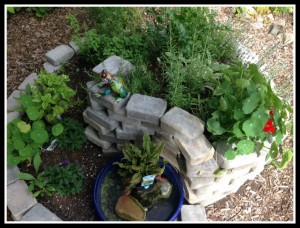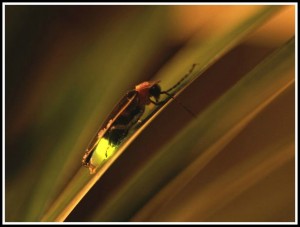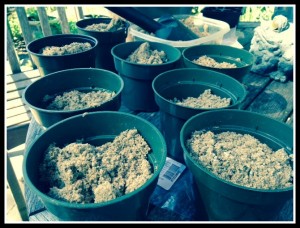The creatures — beneficial bugs, butterflies, bees, and birds, plus a few others — add personality and fun to your garden. In addition, of course, the work they do helps make the garden a success. Serendipity Gardens blog focuses on how to make your garden more wildlife friendly. From the last quarter, here are four most-read posts that tell you how and why. Click on the titles to read the original posts:
Serendipity Garden’s New Spiral Herb Garden
This post documents the process we went through to create a spiral herb garden. Nothing much in the world smells better than a basil leaf in the hot sun, or lemon balm rubbed between the fingers. People like these fragrances, and the creatures do, too! This type of garden is also a good way to maximize the benefits of sun and water, as its design creates multiple climate zones. It’s a good idea to put the herb garden close to a garden seat, so that you can sit there and enjoy watching the visitors. It is also nice to locate it near the kitchen, so you can quickly nab some rosemary or oregano to add to a dish. This photo shows our herb spiral about two months after planting.
Counting Fireflies at Serendipity Gardens
An online student of mine recently wrote about a childhood memory. Here are her words: “When I was age eight, we lived in Louisiana with my grandmother. Our home was on five acres of land, isolated from other homes … one night my mom and I sat out on the front lawn, under the moonlight. Suddenly these lights started flickering before my eyes. At first sight, I thought my eyes were playing tricks on me, but my mom quickly readjusted that thought after she turned to me and said, “Those are lightning bugs.” That was one of the best experiences I shared with my mom as a child. I will never forget it, and now, I wonder. Where did the lightning bugs go?”
Sadly, the number of fireflies appears to be diminishing as their habitat changes and disappears. You can help scientists understand more by becoming a citizen scientist and counting the fireflies. This post tells you how.
Sowing a Butterfly Habitat at Serendipity Gardens
You have doubtless heard that the monarch butterfly is in trouble. The terrible statistic I learned recently was that the total area occupied by monarch colonies at overwintering sites in Mexico has dropped from 20.97 hectares (winter of 96-97) t0 .67 of a hectare (winter of 13-14). Disheartening? Yes. Hopeless? No.
You can help save the monarchs and other butterfly populations, as well as other pollinators, by planting a wildflower garden in your own backyard. We did that this year at Serendipity Gardens, and this post shows the process we used. I cannot speak yet as to the success of the wildflower garden. I can say that many seeds have sprouted, along with a few weeds and other volunteer plants — and that I have high hopes for the butterfly garden’s ultimate success.
Three Reasons to Work Toward Making an Eco-Friendly Garden
- Flowers like this bee balm say “Dinner’s ready!” to butterflies and bees.
The last of the four posts provides three reasons why building a backyard ecosystems is a good idea. The key point is that, in addition to making your garden more wildlife friendly, it makes your work as a gardener easier. The creatures that come love to do many of your garden chores. Moles like to dig, for example, so you can let them do their thing instead of wasting your energy trying to make them go away. Yes, you’ll have a few molehills to rake away, but down underneath, where it counts, you’ll have nicely aerated, loose soil that is easy to plant. If you can stand some leaf damage, natural predators will take care of most if not all of your pest problems. You will have little need to use the pesticides that are causing so much trouble for the larger environment.
It all seems like a pretty good deal to the Serendipity Gardens crew!
Like this post? Sign up to receive an email each time a new post is available. We will never loan, sell or rent your email address — that’s a promise! Please use the buttons below to share with others.



